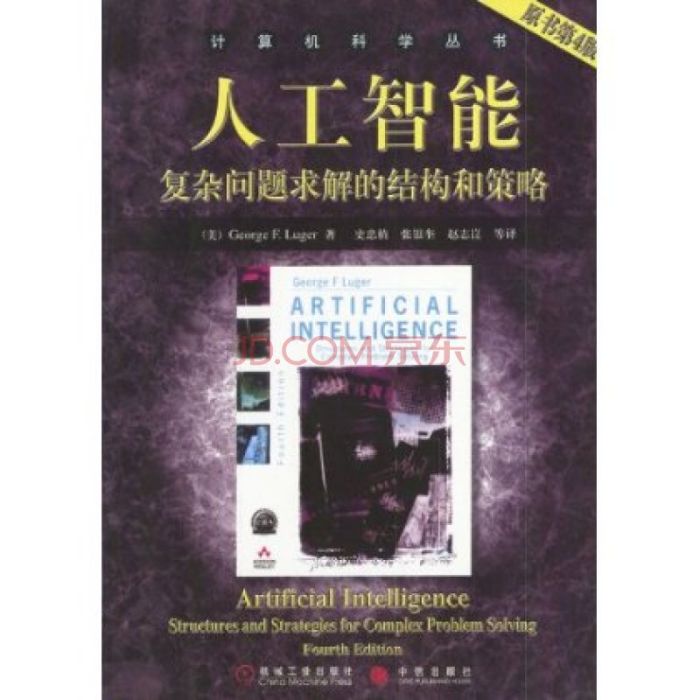《人工智慧:複雜問題求解的結構和策略(英文版)(第6版)》是一本圖書,英文影印版由PearsonEducationAsiaLtd授權機械工業出版社獨家出版。未經出版者書面許可,不得以任何方式複製或抄襲《人工智慧:複雜問題求解的結構和策略(英文版)(第6版)》內容。僅限於中華人民共和國境內(不包括中國香港、澳門特別行政區和中國台灣地區)銷售發行。《人工智慧:複雜問題求解的結構和策略(英文版)(第6版)》封面貼有PearsonEducation(培生教育出版集團)雷射防偽標籤,無標籤者不得銷售。
基本介紹
- 書名:人工智慧:複雜問題求解的結構和策略
- ISBN:9787111256564
- 頁數:753頁
- 出版社:機械工業出版社
- 出版時間:2009年3月1日
- 裝幀:平裝
- 開本:32
- 叢書名:經典原版書庫
作者簡介,媒體評論,目錄,
作者簡介
作者:(美國)盧格爾 (Luger.G.F)
George F.Luger, 1973年在賓夕法尼亞大學獲得博士學位,並在之後的5年間在愛丁堡大學人工智慧系進行博士後研究,現在是新墨西哥大學計算機科學研究,語言學及心理學教授。
媒體評論
“在該領域裡學生經常遇到許多很難的概念,通過深刻的實例與簡單明了的祝圈,該書清晰而準確塏闞述了這些概念。”
——Toseph Lewis,聖迭戈州立大學
“本書是人工智慧課程的完美補充。它既給讀者以歷史的現點,又給幽所有莰術的賓用指南。這是一本必須要推薦的人工智慧的田書。”
——-Pascal Rebreyend,瑞典達拉那大學
“該書的寫作風格和全面的論述使它成為人工智慧領域很有價值的文獻。”
——Malachy Eaton,利默里克大學
目錄
Preface
Publisher's Acknowledgements
PART Ⅰ ARTIFIClAL INTELLIGENCE:ITS ROOTS AND SCOPE
1 A1:HISTORY AND APPLICATIONS
1.1 From Eden to ENIAC:Attitudes toward Intelligence,Knowledge,andHuman Artifice
1.2 0verview ofAl Application Areas
1.3 Artificial Intelligence A Summary
1.4 Epilogue and References
1.5 Exercises
PART Ⅱ ARTIFlClAL INTELLIGENCE AS REPRESENTATION AN D SEARCH
2 THE PREDICATE CALCULUS
2.0 Intr0血ction
2.1 The Propositional Calculus
2.2 The Predicate Calculus
2.3 Using Inference Rules to Produce Predicate Calculus Expressions
2.4 Application:A Logic-Based Financial Advisor
2.5 Epilogue and References
2.6 Exercises
3 STRUCTURES AND STRATEGIES FOR STATE SPACE SEARCH
3.0 Introducfion
3.1 GraphTheory
3.2 Strategies for State Space Search
3.3 using the state Space to Represent Reasoning with the Predicate Calculus
3.4 Epilogue and References
3.5 Exercises
4 HEURISTIC SEARCH
4.0 Introduction
4.l Hill Climbing and Dynamic Programmin9
4.2 The Best-First Search Algorithm
4.3 Admissibility,Monotonicity,and Informedness
4.4 Using Heuristics in Games
4.5 Complexity Issues
4.6 Epilogue and References
4.7 Exercises
5 STOCHASTIC METHODS
5.0 Introduction
5.1 The Elements ofCountin9
5.2 Elements ofProbabilityTheory
5.3 Applications ofthe Stochastic Methodology
5.4 Bayes'Theorem
5.5 Epilogue and References
5.6 Exercises
6 coNTROL AND IMPLEMENTATION OF STATE SPACE SEARCH
6.0 Introduction l93
6.1 Recursion.Based Search
6.2 Production Systems
6.3 The Blackboard Architecture for Problem Solvin9
6.4 Epilogue and References
6.5 Exercises
PARTⅢ CAPTURING INTELLIGENCE:THE AI CHALLENGE
7 KNOWLEDGE REPRESENTATION
7.0 Issues in Knowledge Representation
7.1 A BriefHistory ofAI Representational Systems
7.2 Conceptual Graphs:A Network Language
7.3 Alternative Representations and Ontologies
7.4 Agent Based and Distributed Problem Solving
7.5 Epilogue and References
7.6 Exercises
8 STRONG METHOD PROBLEM SOLVING
8.0 Introduction
8.1 Overview ofExpert Sygem Technology
8.2 Rule.Based Expert Sygems
8.3 Model-Based,Case Based and Hybrid Systems
8.4 Planning
8.5 Epilogue and References
8.6 Exercises
9 REASONING IN UNCERTAIN STUATIONS
9.0 Introduction
9.1 Logic-Based Abductive Inference
9.2 Abduction:Alternatives to Logic
9.3 The Stochastic Approach to Uncertainty
9.4 Epilogue and References
9.5 Exercises
PART Ⅳ
MACHINE LEARNING
10 MACHINE LEARNING:SYMBOL-BASED
10.0 Introduction
10.1 A Framework for Symbol based Learning
10.2 version Space Search
10.3 The ID3 Decision Tree Induction Algorithm
10.4 Inductive Bias and Learnability
10.5 Knowledge and Learning
10.6 Unsupervised Learning
10.7 Reinforcement Learning
10.8 Epilogue and Referenees
10.9 Exercises
11 MACHINE LEARNING:CONNECTIONtST
11.0 Introduction
11.1 Foundations for Connectionist Networks
11.2 Perceptron Learning
11.3 Backpropagation Learning
11.4 Competitive Learning
11.5 Hebbian Coincidence Learning
11.6 Attractor Networks or“Memories”
11.7 Epilogue and References
11.8 Exercises 506
12 MACHINE LEARNING:GENETIC AND EMERGENT
12.0 Genetic and Emergent MedeIs ofLearning
12.1 11Ic Genetic Algorithm
12.2 Classifier Systems and Genetic Programming
12.3 Artmcial Life and Society-Based Learning
12.4 EpilogueandReferences
12.5 Exercises
13 MACHINE LEARNING:PROBABILISTIC
13.0 Stochastic andDynamicModelsofLearning
13.1 Hidden Markov Models(HMMs)
13.2 DynamicBayesianNetworksandLearning
13.3 Stochastic Extensions to Reinforcement Learning
13.4 EpilogueandReferences
13.5 Exercises
PART Ⅴ
AD,ANCED TOPlCS FOR Al PROBLEM SOLVING
14 AUTOMATED REASONING
14.0 Introduction to Weak Methods inTheorem Proving
14.1 TIIeGeneralProblem SolverandDifiel"enceTables
14.2 Resolution TheOrem Proving
14.3 PROLOG and Automated Reasoning
14.4 Further Issues in Automated Reasoning
14.5 EpilogueandReferences
14.6 Exercises
15 UNDERs-rANDING NATURAL LANGUAGE
15.0 TheNaturalLang~~geUnderstandingProblem
15.1 Deconstructing Language:An Analysis
15.2 Syntax
15.3 TransitionNetworkParsers and Semantics
15.4 StochasticTools forLanguage Understanding
15.5 Natural LanguageApplications
15.6 Epilogue and References
15.7 Exercises
……
PART Ⅵ EPILOGUE
16 ARTIFICIAL INTELLIGENCE AS EMPIRICAL ENQUIRY

